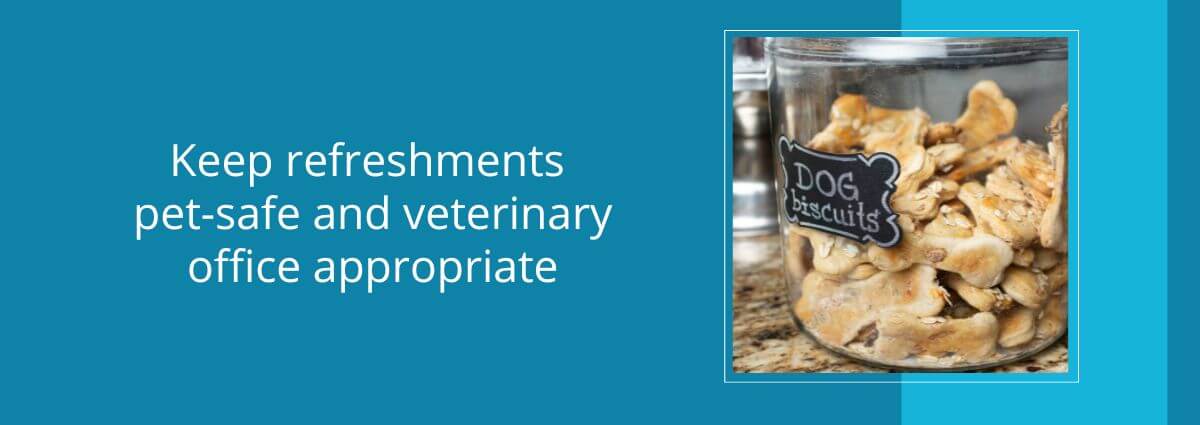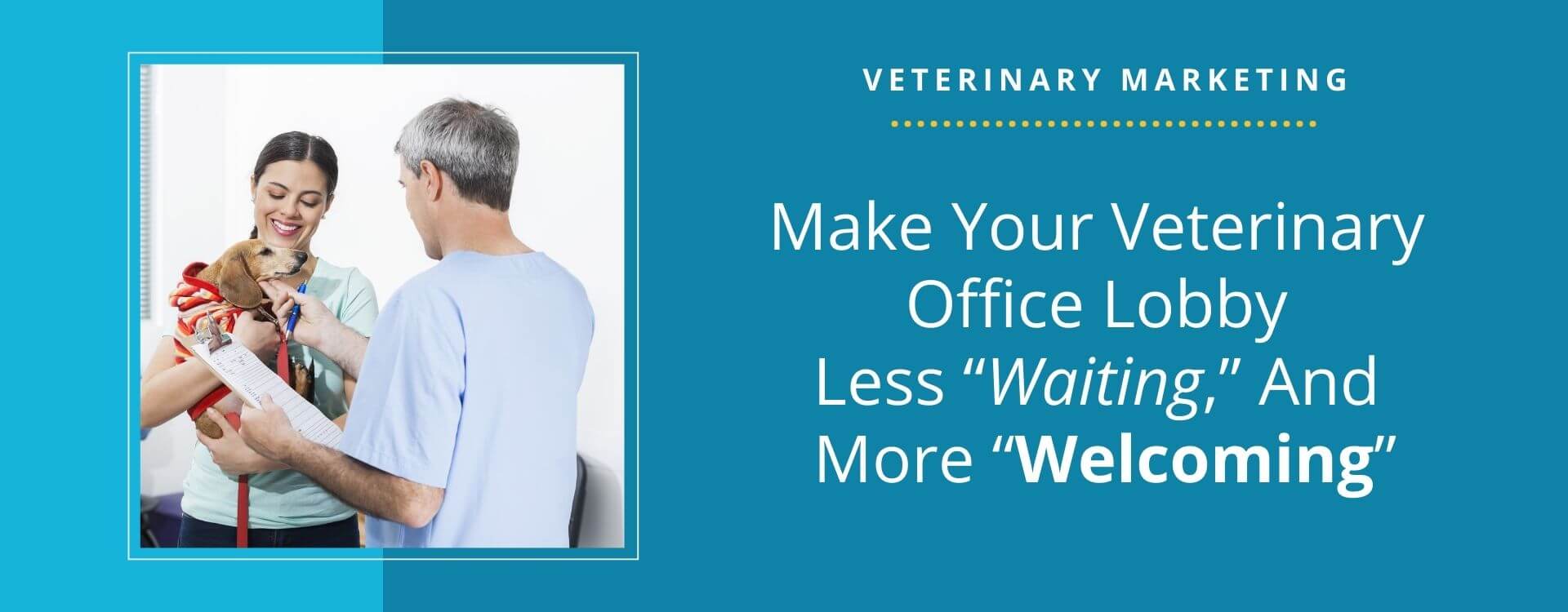Make Your Veterinary Office Lobby Less “Waiting,” And More “Welcoming”
The last thing you want your clients to think about in a veterinary waiting room is...well...waiting! Sure, they were committed enough to keep this appointment, but that doesn't necessarily mean they're bonded to your practice, especially if this is their first visit. Make the first real-life impression of your clinic a great one by making the most of the time before the appointment starts. With a few considerations, you can build and strengthen client bonds from the front door to the exam room door.
Big Welcomes, Even in Small Spaces
Some practices have large, beautiful front lobby areas. Others, of course, have a relatively tight space between the front door and the front desk. And either way, there is a lot of business going through that space.
Regardless of the size of your facility, as soon as a pet owner walks through the door, the most important thing is that you greet them immediately. Your receptionists or client service coordinators should make eye contact and warmly and authentically welcome each person who enters. Before anything else, each pet owner should know that your staff is glad they're here and will be taken care of. Even if the receptionist is on the phone or working with another client, she can make eye contact and smile to acknowledge when someone enters the practice. Ultimately, if a client does not feel acknowledged, they will feel ignored.
There is also the art of paying close attention. Part of receptionist training is honing the skills to know who needs what kind of help. The best front lobby setup will give your staff a view into the parking lot to know immediately if a client is coming in with small children, multiple cat carriers, and/or a large dog. In these cases, your staff needs to extend hospitality beyond the front lobby; they'll head out to the parking lot to help a client get in the door. Take this a step further: train your staff not to ask what someone needs help with; instead, they should graciously say, "Let me help you." The receptionist will hold a carrier, take a leash, open the door, and help the client get situated automatically.

Sometimes the Lobby is "Just for Passing Through"
Any pet owner may appreciate being shown directly into an exam room, regardless of the size and features of the front lobby. But there are some cases in which this is a necessity.
Keeping Cats Calm
Make a special note of how your waiting area can affect sensitive pets like cats. You may have a cats-only exam room, but even if you don't, it should be standard practice to maintain at least one clean, open room as appointments cycle through. Pet owners with cats should be ushered directly into that private space. This will minimize stress for cats who may be fearful of dogs or upset by unfamiliar noises.
Emotional Office Visits
You may not know new clients the same way you know beloved bonded clients, but high-stress appointments will affect them no differently. Your receptionists should know the appointment schedule and keep tabs on when to expect a potentially emotional client. Prioritize the quality of life discussions and euthanasias, and give these patients and clients the private space of a closed exam room. Even well-meaning comments and encouragement from other clients may be difficult for them to take, so let them have their own quiet space.
Avoid a Paperwork Predicament
New clients have one built-in task that can distract from any wait time: New Client Paperwork. While you should provide online forms for pet owners to fill out ahead of time and at their convenience, some people won't do so. When a new client needs to complete paperwork, let them do it inside an exam room. They can set down a carrier or let go of a leash in a safe space where the pet can get comfortable and relax. Then the pet owner has both hands free to take care of the paperwork and even think about questions they may have while filling it out.
An important marketing note: take this opportunity to ask where this new client found out about your practice. This is more than asking, "Did you see us online?" Find out if a neighbor recommended you. Or, perhaps this pet owner googled a symptom and found your blog in the search results. In this way, the waiting room experience can help you gauge which marketing efforts are bringing these new clients into your office.
In The Room Where it (Waiting) Happens
Direct exam room entry is not always an option, and of course, the front lobby is generally where clients will wait ahead of their appointments. Depending on the size and setup of this space, you'll have several options for creating a pleasant and engaging experience. While there may be no single magic formula for the "perfect veterinary office waiting room," there are important points to consider before you choose your lobby's general features:
- Noise - relaxing music or informative videos are good, but overwhelming noisiness is not.
- Decor - tasteful -- even branded -- paint colors and art are nice, but clashing color schemes are unpleasant.
- Information - posters and flyers can help convey vital information to local pet owners, but your whole lobby should not become a crowded bulletin board.
- Retail - provide valuable products for pet health care, but your lobby should not be easily confused with a pet shop -- or worse, a garage sale.

Then, drill down to consider the pros and cons of these specific features:
- A television - You may show videos from your practice or even tune to animal-related or children's television. Note that you cannot control televised commercials that may not be appropriate or "on-brand," and you should maintain a reasonable volume.
- A radio - Paying for a satellite service may be safer for quality control, but a broadcast classical or easy-listening station may please your clientele. However, you must be savvy about these tastes, and as with a television, be careful with the noise level.
- Flyers, pamphlets, and handouts - Whether for upcoming events, new preventive care recommendations, or missing pets, some of this informative material will inevitably be displayed in your waiting area. Notice the word "some"; if you have too much paper in your lobby, the messages will drown each other out, and your practice could look messy.
- Retail - You want to ensure that pet owners follow your recommendations for pet toothpaste, hypoallergenic treats, and more, but you don't have to put all of your inventory on display. Be thoughtful about what will be visually appealing and what will actually sell. If you don't have the space, establish consistent standards for what your staff members should say when asked about pet products and retail stores.
- Refreshments - Both people and pets will appreciate access to fresh water. Even if you don't leave water bottles or bowls sitting out, your receptionists should be able to offer these, particularly on hot days. Snacks entirely depend on whether you have clean, clear display space. A jar of dog treats on the front desk is pretty straightforward, but freshly baked cookies for pet owners are an entirely different matter. Instead of providing items that require preparation or could be dangerous to pets, if snacks are important to your culture and set up, consider individually wrapped items like crackers or dried fruits.

- Wifi - Who doesn't want to scroll through Instagram or Twitter to pass a bit of time? You can make it easier for pet owners to browse social media -- and follow your business pages -- by providing free wifi. Know your limitations, however. If your staff computers and client cell phones would all need to run off the same router, the lag may lead to more frustration than follows.
One of our other favorite suggestions for the waiting area in a veterinary practice is to find a corner or a wall and set up an Instagram backdrop that would be a fun setting for taking pictures of clients' pets. You can update this seasonally or on a regular basis, and be sure to work your hospital logo into the background. Put up a sign that says, "While you wait, take a photo of your pet next to our Instagram wall, and post it to both Instagram and Facebook with the hashtag "#PracticeNamePets," and you will automatically be entered to win a free wellness visit and a loaded goodie bag! Ensure the staff encourages clients to do it. What happens is clients will post their pet pictures, and many of their friends and neighbors will like it, causing many of their friends to see it—this creates a great little viral pop in your local area, and all of them are seeing that the pet is happy and at your clinic.
Then at the end of the month, you simply search for your hashtag to see all the posts and select your winner. Do this monthly, and you'll be amazed at how much joy and recognition it creates.
Cleanliness, of course
It should go without saying that cleanliness and fragrance are of the utmost importance. Part of high-quality veterinary care is maintaining clean, orderly appearances. It's entirely natural to have a strong adverse reaction to mess and foul odors, and you can help make sure that your clients have just the opposite reaction at your clinic! Better that they don't notice any odor so they can focus on the excellent client service you'll provide. So keep it clean!
When You're Running Behind
Even with the perfect balance of decor, pleasant chit-chat with the receptionists, and maybe even a visit from the clinic cat, waiting is still waiting. Then, the "simple" thing is always to run precisely on time! But realistically, no one has complete control over a medical schedule, and studies show that clients expect to wait nearly 15 minutes for appointments. Any longer, however, they can become irritated.
If an emergency or other issue does throw your schedule off, even just a bit, you should provide updates. Without giving away private information about other pets and families, your receptionists can honestly say that your team is taking care of a medical emergency. Your staff training can also include standards for shifting your team to pick up when others fall behind and when it may be appropriate to offer a new appointment over a long wait.
And here is where all the tactics mentioned above can come into play. Because "unoccupied time feels longer than occupied time," even if your staff is on schedule, you can create a great waiting room experience that seems to take no time at all if your team is caring and attentive. Open the door for a mom with her kids, scratch her dog's chin, and tell them you're happy to see them. Then, a comfy chair in a clean lobby with a pamphlet about changes to expect in a senior pet can make a few minutes of wait time fly right by.

A veterinary office front lobby could include a small front desk or oversized chairs, soft classical music or photos from local fundraisers, dental chews for sale, or free training treat samples. But no matter how much they vary, every front lobby should convey a sense of warmth. If your receptionists greet each pet owner with a caring attitude, that will build trust. Be attentive and considerate of their time and their pet's needs, and you'll welcome them into your lobby again and again as bonded clients and patients.
You can learn more about being warm and welcoming to pet owners in your practice and online. Contact us for a FREE consultation with one of our GeniusVets experts!

